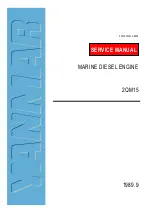
GB
2
Gasoline and its vapors are extremely flammable and explosive.
Fire or explosion can cause severe burns or death.
WHEN ADDING FUEL
•
Turn engine OFF and let engine cool at least 2 minutes before removing gas cap.
•
Fill fuel tank outdoors or in well‐ventilated area.
•
Do not overfill fuel tank.
•
Keep gasoline away from sparks, open flames, pilot lights, heat, and other ignition
sources.
•
Check fuel lines, tank, cap, and fittings frequently for cracks or leaks. Replace if
necessary.
WHEN STARTING ENGINE
•
Make sure spark plug, muffler, fuel cap and air cleaner are in place.
•
Do not crank engine with spark plug removed.
•
If fuel spills, wait until it evaporates before starting engine.
•
If engine floods, set choke to OPEN/RUN position, place throttle in FAST and crank
until engine starts.
WHEN OPERATING EQUIPMENT
•
Do not choke carburetor to stop engine.
WHEN TRANSPORTING EQUIPMENT
•
Transport with fuel tank EMPTY.
WHEN STORING GASOLINE OR EQUIPMENT WITH FUEL IN TANK
•
Store away from furnaces, stoves, water heaters or other appliances that have pilot
light or other ignition source because they can ignite gasoline vapors.
WARNING
Rapid retraction of starter cord (kickback) will pull hand and arm
toward engine faster than you can let go.
Broken bones, fractures, bruises or sprains could result.
•
When starting engine, pull cord slowly until resistance is felt, then pull rapidly.
•
Direct coupled equipment components such as, but not limited to, blades,
impellors, pulleys, sprockets, etc., must be securely attached.
WARNING
Rotating parts can contact or entangle hands, feet, hair, clothing, or
accessories.
Traumatic amputation or severe laceration can result.
•
Operate equipment with guards in place.
•
Keep hands and feet away from rotating parts.
•
Tie up long hair and remove jewelry.
•
Do not wear loose‐fitting clothing, dangling drawstrings or items that could become
caught.
WARNING
Unintentional sparking can result in fire or electric shock.
Unintentional start‐up can result in entanglement, traumatic amputation, or
laceration.
BEFORE PERFORMING ADJUSTMENTS OR REPAIRS
•
Disconnect spark plug wire and keep it away from spark plug.
WHEN TESTING FOR SPARK
•
Use approved spark plug tester.
•
Do not check for spark with spark plug removed.
WARNING
•
Allow muffler, engine cylinder and fins to cool before touching.
•
Remove accumulated combustibles from muffler area and cylinder area.
•
Install and maintain in working order a spark arrester before using equipment on
forest‐covered, grass‐covered, brush‐covered unimproved land. The state of
California requires this (Section 4442 of the California Public Resources Code).
Other states may have similar laws. Federal laws apply on federal land.
WARNING
Running engines produce heat. Engine parts, especially muffler, become
extremely hot.
Severe thermal burns can occur on contact.
Combustible debris, such as leaves, grass, brush, etc. can catch fire.
OIL RECOMMENDATIONS
CAUTION:
Engine shipped from Briggs & Stratton without oil. Before starting engine, fill with oil. Do not
over‐fill.
•
Use a high quality motor oil.
•
Do not use special additives. Do not mix oil with gasoline.
•
Choose a viscosity according to average temperature such as SAE 30 weight oil, see
chart below.
°
C
‐30
°
F
‐20
0
20
40
60
80
100
‐20
‐10
0
10
20
30
40
*
**
32
CAUTION:
*
Air cooled engines run hotter than automotive engines. The use of
non‐synthetic multi‐viscosity oils (5W‐30, 10W‐30, etc.) in temperatures above
40
°
F (4
°
C) will result in higher than normal oil consumption. When using a
multi‐viscosity oil, check oil level more frequently.
**
30 weight oil, if used below 40
°
F (4
°
C), will result in hard starting and possible
engine bore damage due to inadequate lubrication.
OIL CAPACITY
•
Engine holds approximately 0.61 liter (20 oz).
Fig. 2
OIL PROCEDURE
•
Check oil level before every use and after every eight (8) hours of continual use.
1. Place engine level and clean around oil fill .
2. Remove dipstick, wipe with clean cloth
, insert and tighten down again
. Remove
dipstick and check oil level. Oil should be at FULL mark
. If oil is required, add slowly
.
Recheck oil level on dipstick
.
3. Do not over fill. Overfilling with oil may cause smoking, hard starting, spark plug fouling,
and oil saturation of air filter. Drain out excess, if oil level is over FULL mark on dipstick.
4. Tighten dipstick firmly before starting engine.
FUEL RECOMMENDATIONS
Use clean, fresh, lead‐free gasoline with a minimum of 85 octane. Leaded gasoline may be
used if it is commercially available and if unleaded is unavailable.
In U.S.A. leaded gasoline may not be used. Some fuels, called oxygenated or reformulated
gasolines, are gasolines blended with alcohols or ethers. Excessive amounts of these
blends can damage the fuel system or cause performance problems. If any undesirable
operating symptoms occur, use gasoline with a lower percentage of alcohol or ether.
This engine is certified to operate on gasoline. Exhaust Emission Control System: EM
(Engine Modifications).
Do not use gasoline which contains Methanol. Do not mix oil with gasoline.
Before refueling, allow engine to cool 2 minutes.
WARNING
Fig. 3
ADDING FUEL
Clean around fuel fill
before removing cap. Fill tank to approximately 1 inch below top of
neck
to allow for fuel expansion. Be careful not to overfill.





































